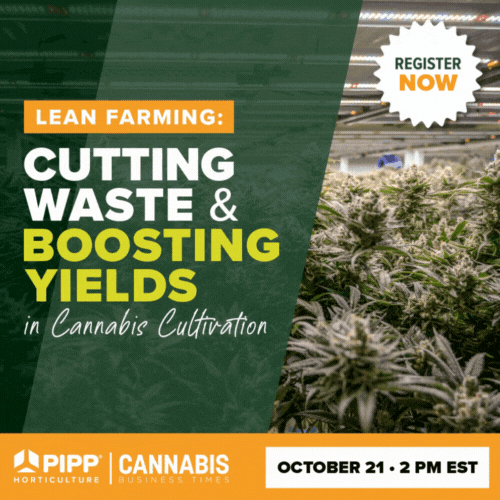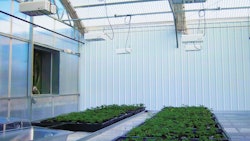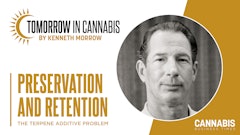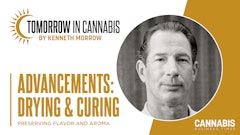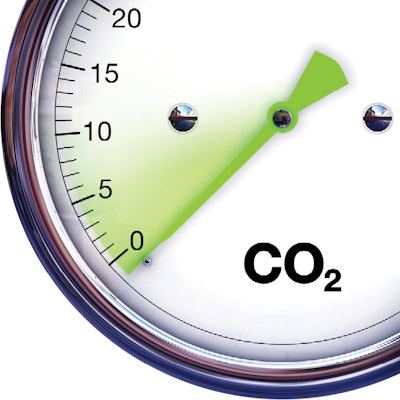
As cultivators transition to large-scale indoor or greenhouse production, one especially important concept to grasp is air-quality in relation to plant growth, health and productivity. All growers understand that plants grow better with carbon dioxide supplementation, but they must also understand other environmental gases that can affect plant growth and health.
Air quality is an important growth component, and both environmental air and oxygen are key factors. Proper oxygen levels must be maintained in nutrient solutions used to water plants. And, regardless of growth method — ebb and flow, drip feed or any form of hydroponics — carbon dioxide (CO2), oxygen (O2) and water (H2O) levels must be in perfect balance at all times. This balance of CO2, O2 and H2O (water vapor in the form of humidity) must be constantly monitored and maintained to achieve maximum productivity and prevent unhealthy conditions that encourage mold/mildew and infection.
There are many aspects to hydroponic systems and indoor/greenhouse controlled environments regarding atmospheric/element environmental gases that some growers never consider. These gases sometimes go unnoticed because they are not felt nor seen. Here is a basic explanation of oxygen, carbon dioxide and water vapor, as well as ethylene, and how they impact plant growth and health.
Oxygen (O2)
Most growers consider CO2 levels their main environmental factor after humidity and temperature, frequently overlooking the importance of minimum environmental oxygen levels, especially when attempting to construct a sealed environment without outside air supplementation. (Outside air contains approximately 20-percent oxygen.) Closed-loop systems without outside air supplementation often suffer from detrimental effects caused by inadequate oxygen levels available to the plant root systems. Plant roots require oxygen to metabolize both nutrients and water.
Typically, growers resist supplementation with environmental air because proper air filtration and sterilization can be costly (greenhouse growers utilize specific-sized bug screens on all air intake and exhaust ventilation openings), and with air intake comes air exhaust, which then brings up issues with odor/smell abatement. HVAC manufacturers can engineer systems that mitigate these issues, but again, these can be expensive. Some growers can’t afford them, and others just don’t understand the importance of a properly controlled environment.
But it is simple, really. You must maintain a 20-percent oxygen level in growing environments, and the most efficient method to do so is to supplement your air with outside filtered, sterilized, temperature-adjusted fresh air.
As mentioned earlier, oxygen is an important factor in water/nutrient delivery as well. Hydroponic reservoirs must be properly aerated and monitored for oxygen levels at all times. Water temperature dictates the oxygen percentages the water can achieve. 62°F is the temperature at which water holds maximum oxygen levels. Lower temperatures hold less oxygen and are not advantageous to healthy growth, whereas higher-temperature water holds less oxygen and promotes and/or contributes to detrimental pathogen levels in hydroponic systems.
Water chillers are used to maintain water temperatures in warmer climates or in summertime heat. Aeration is achieved by aerators that bubble air/oxygen into the water. The bubble size used for aeration is also important, because smaller bubbles have less surface area and provide higher oxygen levels than larger bubbles. It’s important to note that sterilized oxygen-rich air must be used for nutrient/water aeration to prevent infection of the solution or a pathogen outbreak.
Regardless which watering methods you use, you need to consider all water oxygen levels as important as the water’s pH. Every cultivator needs some form of dissolved oxygen meter, either handheld or incorporated into the water delivery system.
Carbon Dioxide (CO2)
Carbon dioxide is used to produce carbohydrates that are essential for plant photosynthesis. When CO2 levels drop, photosynthesis/growth, productivity and health diminishes as well. Lower levels of CO2 produce lower levels of carbohydrates, which ultimately translates into less growth. Outside environmental levels of CO2 are approximately 400 ppm.
High light levels can quickly decrease CO2 levels in both indoor and greenhouse environments when plants are rapidly growing because CO2 uptake is increased/accelerated with the elevated light levels. To compensate for lower CO2 levels, growers use supplemental CO2 gas, either in pure gas form or by implementing natural gas burners that produce CO2 as a waste gas.
While many growers simply maintain CO2 levels at 400 ppm at all times, others understand CO2’s importance and strive for levels up to 1,000 ppm and above. They recognize that they can accelerate plant growth in a finely tuned environment. Simply put, low CO2 levels lead to slower growth than elevated levels.
Liquid CO2 is most commonly used. It is stored in a large, rented or leased tank that must be in a location that offers easy access for a delivery driver to fill the tank as needed.
With a CO2 gas system, proper delivery, monitoring and safety sensor equipment must be incorporated. Gas burners are easy to install and use, but they produce heat, which may not suit all environments. (They sometimes are employed only in colder climates or during colder seasons.) The heat produced can cause elevated temperatures, which can result in accelerated transpiration, which in turn raises humidity levels in improperly ventilated environments or closed-loop/sealed environmental situations. Defective or improperly adjusted burners can produce unhealthy and poisonous gases, such as carbon monoxide and ethylene gas.
I have heard legislators and the uneducated spout a huge misconception that some terrible man with a hazmat suit mixes poisonous gases together to produce CO2, which is then used by “dope” growers to pollute the environment. The reality is far from that.
CO2 gas that plant growers use is taken out of environmental air by a very clean method and produced in liquid form in pressure-safe tanks. When a grower injects the gas into a growing environment, the plants use the gas and diminish the gas levels, whereupon more gas is injected to maintain desired levels. Any CO2 gas that ultimately gets ventilated is minimal. In fact, growers are actually helping to eliminate CO2 gas.
Water (H2O)
Water in the form of a gas (water vapor) is measured as relative humidity or vapor pressure deficit. Excessive water vapor/humidity can have detrimental effects on many aspects of plant growth and development and, as previously mentioned, promotes the growth of a proliferation of pathogens, botrytis/mold and mildew. Excessive humidity will inhibit transpiration and nutrient/water uptake as well.
Ethylene (C2H4 )
Ethylene gas has many interesting aspects, both positive and negative. Little data exists regarding cannabis and ethylene gas, but application or buildup of the gas in most plant-growth stages can be detrimental. It can inhibit growth, maturation, and cannabinoid and essential oil production.
Ethylene is a hydrocarbon. It is a colorless, flammable gas with a slight sweet and musty odor at elevated levels, and is widely used in the chemical industry. Ethylene is a natural plant hormone used in agriculture to force the ripening of fruits. It is present in trace amounts throughout a plant’s life, stimulating or regulating the ripening of fruit, the opening of flowers and the abscission (shedding) of leaves.
Ethylene production also can be induced by a variety of external influences, such as physical wounding, environmental stress and certain chemicals (including auxin). Environmental influences such as excessive or under watering, extreme temperatures (both hot and cold), pest and disease/pathogen attack can induce ethylene production. When plants are over watered, roots suffer from a lack of oxygen and become stressed, inducing the plant to produce ethylene. Many growers also have found out the hard way that carbon dioxide burners and the exhaust fumes from inefficient greenhouse heaters can raise the ethylene concentration to 0.05 ppm, causing delay in flowering of commercial crops.
Here is a list of responses plants can have to ethylene:
- Stimulates seedling triple response, thickening and shortening of hypocotyl with pronounced apical hook
- Stimulates arabidopsis hypocotyl elongation
- Stimulates leaf and flower senescence (aging)
- Stimulates senescence of mature xylem cells in preparation for plant use
- Induces leaf abscission (shedding)
- Induces seed germination
- Induces root hair growth, increasing the efficiency of water and mineral absorption
- Induces growth of adventitious roots during flooding
- Stimulates fruit ripening
- Induces a climacteric rise in respiration in some fruit/plants, which causes a release of additional ethylene
- Affects gravitropism (the direction in which stems and roots grow)
- Inhibits stem growth, and stimulates stem and cell broadening and lateral branch growth outside of seedling stage
- Interferes with auxin transport (with high auxin concentrations)
- Inhibits shoot growth and stomata closing
(Source: Some of the above points were excerpted or adapted from Wikipedia.)
Plants can be induced to flower either by treatment with ethylene gas in the chamber or by placing a banana peel next to a plant in an enclosed area.
Again, little research has been performed regarding cannabis. The ethylene influences listed show that there are many possible positive uses for ethylene gas application in specific growth stages.
Ethylene meters are an unnecessary expense; a CO2 monitor and an oxygen monitor are all that are needed when CO2, oxygen, humidity, temperatures and ventilation are properly maintained. If all other parameters are within their desired set points, the likelihood of an ethylene buildup is very minimal. But now that you know the damage ethylene gas is capable of, be vigilant and observant.
I once observed a very healthy, ripe crop of 200 indoor cannabis plants seemingly spontaneously shed all their large fan leaves the day of harvest, and any leaves left fell off when the plant was cut. This eliminated 25 percent of the hand de-leafing without compromising quality or quantity. The growing environment was completely hermetically sealed. Based on observation, I can only surmise that ethylene buildup caused the shedding of leaves, although without an ethylene meter, I had no way to confirm that. However, if a grower could induce the plants to drop larger leaves at will and eliminate 25 percent of de-leafing labor, that would certainly be a cost—saving advantage.
Ethylene is a natural, organic gas, not some devious synthetic chemical. Your grandmother probably ripened fruit with ethylene gas from a banana many years ago. Think of ethylene, when used strategically, as a “Jeffrey.” As explained in the movie “Get Him to the Greek,” “Who could be afraid of a Jeffrey? Jeffrey is just a nice bloke down the road, inne?”

